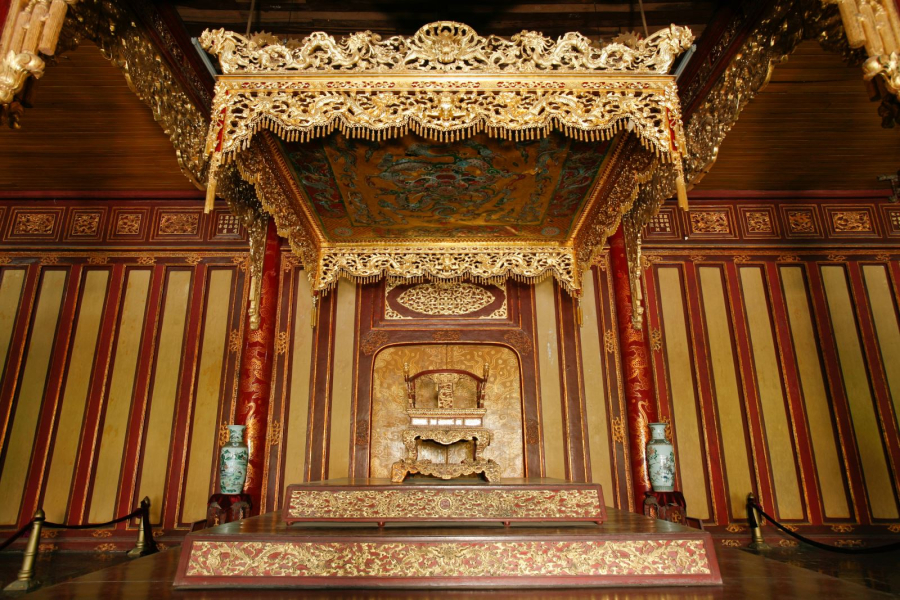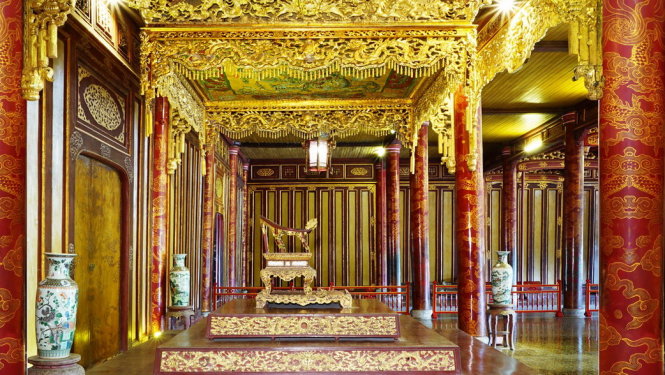The Nguyễn Dynasty (1802-1945) is the last and only dynasty to leave behind an intact golden throne until today. The throne is 101cm tall, 72cm wide, and 87cm long. The base measures 118cm long, 90cm wide, and 20cm high.
The golden throne is placed in the most important position in the Throne Hall, where the emperor held grand ceremonies twice a month on the 1st and 15th days of the lunar calendar. The Throne Hall is also where important royal ceremonies took place (such as the coronation of the emperor, birthdays, and meetings with ambassadors).
During the reign of Emperor Khải Định (1916-1925), the golden throne underwent meticulous restoration. The emperor had the upper section of the throne, which was originally made of silk, redone in lacquered wood adorned with gold and delicate carvings.

The Hue Imperial Citadel Conservation Center reveals that the golden throne of the Nguyễn Dynasty is currently preserved in the Throne Hall, located in the Imperial City of Huế.
In January 2016, the golden throne was classified as a national treasure, with significant historical, cultural, and artistic value.
The Nguyễn Dynasty lasted for 143 years, with a total of 13 kings sitting on this golden throne. The golden throne was completed during the reign of Emperor Gia Long, the first emperor of the Nguyễn Dynasty. The last emperor of the Nguyễn Dynasty, Bảo Đại, also sat on this golden throne and was the final person to do so. Emperor Tự Đức had the longest reign on the golden throne, ruling for 36 years, from 1847 to 1883.

Most notably is the story of 4 months and 3 emperors of the Nguyễn Dynasty. The event took place after the death of Emperor Tự Đức. As Tự Đức had no descendants, the king adopted 3 of his grandnephews as his sons. Dục Đức was chosen as the successor. However, Dục Đức, the 5th emperor of the Nguyễn Dynasty, was dethroned after only 3 days due to an accusation of tampering with the will left by Emperor Tự Đức. Dục Đức was subsequently imprisoned and died of starvation.
After Dục Đức, Emperor Hiệp Hoà ascended to the throne but held it for only 4 months before being executed according to the royal protocol for approving the removal of two powerful ministers, Tôn Thất Thuyết and Nguyễn Văn Tường.
Prince Ưng Đăng, later known as Kiến Phúc, inherited the throne at the age of 15. However, witnessing the consecutive deaths had a severe impact on his mental state, and he fell ill and died after only 8 months.

Another remarkable detail is that during the 143 years of existence of the Nguyễn Dynasty, the golden throne in the Throne Hall has never been moved from its original position. According to researcher Phan Thuận An: “There were periods when the golden throne witnessed bloodshed in the struggles for the throne, like during the 4 months and 3 emperors, but no one ever moved the golden throne elsewhere.”
According to the research by Phan Thuận An, people in Huế have never dared to take a single roof tile or brick from the Imperial City for personal use. Even after the Nguyễn Dynasty ended and the country went through a period of division, no one dared to sit on the golden throne or trespass in any way.






































